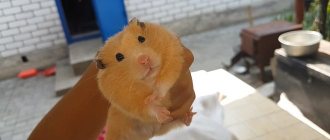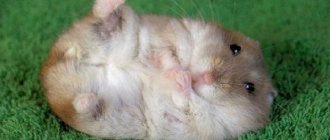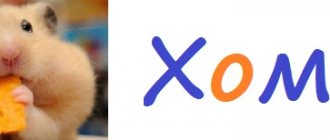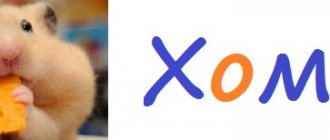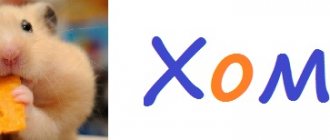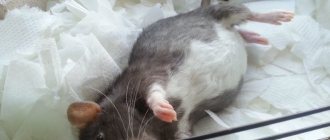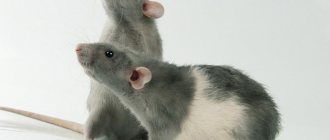Let's start with a couple of lines of encyclopedic information. Do you want to know where your animal comes from and what it is like? And then we’ll immediately talk about caring for Syrian hamsters.
One of the cutest pets.
Syrian hamsters (aka royal, golden, golden) were first mentioned in the 18th century, but a scientific description appeared only in 1836. They were discovered near Aleppo (Syria), which is why they got their name. After this, the rodent was considered extinct for a long time, because The stubborn Syrian hamster did not show itself to the researchers.
The cunning Syrian, foreseeing the future of toys for children and laboratory “consumables” (joke), migrated to the territories of modern Israel, Turkey, Iran, the Balkans, where he still lives safely.
The Syrian hamster hid for almost 100 years, and in 1930, an Israeli zoologist discovered a female with 12 hamsters. Only 4 survived, but this was enough for the rodent to become one of the most popular pets in our time.
What does a Syrian look like and how big will it grow?
Description. The Syrian hamster is a rodent belonging to the hamster family. It has a dense, “strongly built” body - the largest among domestic hamsters. The tail is small and inconspicuous. The predominant color is golden (we’ll talk about types of coats and colors below).
There are rumors that the Syrian hamster has 5 toes on its hind legs and 4 on its front legs. This is not true, there are also 5 on its front legs. It’s just that the thumb is so poorly developed that you can’t even see it.
The average length of an adult royal hamster is 12 cm, the weight of a male is 100-130 g, females - 110-140. But under conditions of good care and nutrition, some eat up to 12 cm in size and weigh 200 g. This is not the result of obesity, just a large animal - it looks almost like a guinea pig.
When choosing a sex, keep in mind that a mature male is more friendly and easier to tame. Female Syrian hamsters often have a bad and aggressive mood.
An adult male with a female in comparison (the female is bicolor).
Arrangement of the cage
The Syrian hamster, its care and maintenance plays an important role. But providing the most basic needs is of utmost importance. One of these needs is a cage of sufficient size and with the correct contents. For this type you need a minimum size of 50x30 centimeters. Try to fill it as much as possible. There are many accessories that can add variety to your pet's life.
Make a variety of tunnels whenever possible. Ideally, they connect two cells. But remember, there is only one animal per dwelling (cage). If the fluffies meet somewhere, they won’t be so kind. Each will defend their territory and both will be susceptible to stress and injury. Deaths are not uncommon.
Each cage must have bedding. They buy a special filler for the bottom that absorbs moisture and odor. It is best to use corn.
Types of fur of the royal rodent
There are 3 main varieties of Syrian hamsters based on their coat type.
Satin . Classic shorthaired Syrians. Often the coat is "glossy", which makes the hamster shine in the light.
Long-haired . A detachment of royal rodents with long hair (individuals with a hairstyle 8-10 cm long are known). Often these Syrian hamsters are also called Angora or Persian. The abundant coat requires special care, so we have dedicated separate material on the website to Angora pets.
And I'm not the shaggiest yet!
Rex. Bred relatively recently, they are covered with thick wavy hair that looks like curls.
A little history
The Syrian hamster (Cricetus Auratus) was first mentioned back in 1797 in an article by the Russell brothers. Already in 1839, there were so few rodents that they began to be considered extinct. Zoologist Israel Ahoroni searched for them for a long time and finally found them on April 30, 1930. He discovered a burrow containing an adult female and her litter of 11 cubs. To preserve their appearance, they were taken with them to the University of Judaea. Unfortunately, the majority died for one reason or another, only one female and 3 males remained (according to other sources, no one died and the same number were found). To preserve the species, they had to be reproduced, but there cannot be such connections between the family, so as not to spoil the genetics. Therefore, they were crossed with another rare species. By the end of the year, the number in captivity had grown to 150 individuals. Other searches for the golden hamster were unsuccessful. In 1938, scientists concluded that they had become completely extinct. Fortunately, the rodents were simply never found, and still live in Iran, Turkey and the Balkans.
Colors of Syrian hamsters
The original color of the Syrians is golden (reddish-red, sometimes called peach). But now Syrian hamsters have been bred to come in almost any color. List of main colors of Syrian rodents:
- White (sometimes snow white is distinguished separately)
- Beige
- Yellow
- Smoked
- Copper
- Sable
- Black chocolate
- Grey
Classic color.
Main characteristics
- Length: 13-14 cm.
- Weight: 100-125 g. It is important for the owner to know how much his Syrian hamster weighs. Both obesity and underweight are dangerous. You can purchase a small kitchen scale for weighing.
- Color: golden, beige, black, sand, white, silver, etc.
- Life expectancy: 2-2.5 years.
- Character: independent, that is, it does not require much attention, but is easily tamed, loves hands and affection. Very curious.
Caring for a Syrian Hamster
Proper maintenance and care of a royal hamster consists of:
- Have a comfortable home
- Physical activity
- Hygiene
- Good nutrition
- Protection from stress
- Veterinary treatment
What should a pet's house (cage) be like?
Recommendations for house size for the Syrian breed vary greatly, we will try to answer this question as simply as possible. Choose a cage of such a size that maintenance is easy and it can accommodate:
- House for the night
- Toilet
- Utensils for food
- Drinking bowl
- running wheel
Place accessories freely so that the toilet and eating area are as far apart as possible. Additional options in the form of a labyrinth or a second or third level will make the adult pet’s home more comfortable.
What to prefer: a cage, an aquarium, a terrarium or something else? The most suitable option is a cage, and it is easier to care for than other options. An aquarium of sufficient size is also good, but the cage has better air circulation. Good options include a terrarium or a homemade glass shelving unit.
Do not keep your Syrian hamster in a jar or cardboard box. They are too crowded and the small rodent has to sleep in its own excrement. And the lack of “sports equipment” will greatly affect the baby’s health (we will cover this issue a little lower).
Place the house in a quiet place - caring for a Syrian rodent involves the absence of noise. Sudden loud noises will cause him stress and possibly inappropriate behavior. Those. the living room and kitchen are not suitable. The bedroom is also not an option: the hamster is a nocturnal animal and will not let you sleep. One way out is to leave the cage in the bedroom during the day and move it to the living room at night.
Why does a Syrian hamster need to exercise?
In the wild, a hamster runs up to 12 km per night - there is no feeder, and food must be looked for. At home, with proper care, there is plenty of food, it’s not far to run for it. As a consequence - obesity and all the ensuing consequences (problems with the cardiovascular, endocrine systems, musculoskeletal system). Simply put, it will become more difficult for the pet to move, a heart attack is possible, and the likelihood of diabetes increases (although it is much less than in dwarf varieties).
This is why wheels and labyrinths are placed in the cage. You can also use a special walking ball for hamsters.
We strongly do not recommend walking on the street. Open spaces, noise, sunlight will lead to severe stress after the comfort of an apartment. There is also the possibility of picking up parasites somewhere on the lawn or simply losing a nimble little one.
Luxurious apartment with a gym for a rodent.
Hygiene for a healthy hamster
The royal hamster will definitely equip a toilet in the house. You should not try to accustom him to a certain place - it will be easier to care for if you see where he chooses a latrine, and only then install a kennel and a bowl of food as far away as possible.
There should be filler on the floor of the cage, the layer thickness is 2 cm. Typically used:
- Sawdust
- Corn filler
- Granulated
- paper
Experiment for yourself, which is more convenient and fits your budget. Pieces of paper are a cheap care option, but choose ones without fragrances or other additives. Your pet may develop allergies, and in the worst case, poisoning when he tries to eat the bedding. The main thing is not to use cotton wool or other fibrous materials - the baby may simply get entangled and even suffocate.
The filler also requires regular maintenance - change it at least once a week, preferably 2. You can read in detail about how to choose a filler and how they differ in a separate article on the website.
At least once a week, clean the cage and do a wet cleaning. When caring for the house, do not use detergents with a strong smell - the Syrian hamster may refuse to return to the house. Don't forget to take care of your pet's pantry: don't throw everything away, but remove perishable foods.
The correct “ground floor” of the house with bedding.
About bathing a hamster
The Syrian hamster lives in the steppe. He not only doesn’t like water, he hates it!
Do not resort to water procedures unless absolutely necessary. But if you really have to (a quickie gets into something, it happens), read carefully about how to bathe a rodent here.
The Syrian hamster handles hair care itself - with the help of its tongue and paws. If you want to help him care for him, place a container of sand (sold in pet stores). It is with this “bathing” that Syrian pets clean themselves in nature.
Is it possible to bathe
Nature does not provide for hamsters to bathe in water; they take care of themselves by washing their paws and cleaning their fur several times a day.
During the short life of Syrian hamsters, it is unlikely that the owners will need to bathe them in water, but in exceptional cases this can be done. Bathing is carried out very quickly under running warm water using zoo shampoo for rodents, without wetting the head and face. After bathing, the animal should be dried as quickly as possible: blot the fur with water-absorbing material and dry with a hair dryer with a warm stream of air.
Bathing your pet can be fraught with stress, at the very least, and if it becomes hypothermic, it can become seriously ill.
What to feed your Syrian hamster?
The Syrian diet in nature consists of:
- Seeds and cereals (the basis of rodent nutrition)
- Herbs
- Insects
In your home life, also try to adapt to this list.
A mixture of grains and seeds is the main thing you need to give your pet. An excellent option is ready-made dry food for hamsters. If the manufacturer has enriched the composition with vitamins and minerals, even better.
Do not buy food for other rodents and animals. Some substances that are harmless to large pets can poison the baby.
If you prefer to control the composition of the food yourself, and caring for the animal gives you pleasure, here is a simple video instruction for preparing the mixture.
The most common set is oats, millet, corn, and some seeds.
You can also add some nuts to the food (except for almonds and Brazilian almonds - they contain a high concentration of substances dangerous to rodents).
The Syrian hamster will also benefit from greens (lettuce, dill). Eliminate onion and garlic shoots and sorrel from your diet.
In season, add fresh vegetables, fruits and berries to your menu. But this should be done carefully. The Syrian is not as prone to diabetes as the Djungarian, but still avoid overly sweet fruits and starchy vegetables. Use the glycemic index table of foods - very useful information for those who care for the Syrian animal. Try not to give foods that have a GI of more than 50 - an excess of easily digestible carbohydrates.
Don't forget about protein. Buy ready-made dried insects or feed your pet 1-2 times a week with the following products of your choice:
- Egg white
- Boiled chicken breast
- Boiled lean white fish
Lactating and pregnant females, as well as their offspring, need special care and more protein - give protein foods a little daily.
Syrian hamsters' teeth grow throughout their lives. Place a mineral stone or piece of wood in the cage to grind down the fangs.
We talk in detail about what you can and cannot feed your golden hamster in a separate article on the website.
When in season, berries are an excellent addition to your diet.
Housing structure, habitat
It is not recommended to put hamsters in an aquarium; they feel insecure in it, since they do not feel protected there. Most often, the Syrian hamster is placed in a cage. Its minimum dimensions are 30 by 40 cm, but it is desirable that the cage be larger.
The distance between its rods should be no more than 1 cm, otherwise the animal will be able to escape . These are very fast and active animals, so it is very important that the cage has at least 2 levels. On the first level there is usually a dining room and a playroom, and on the second level you can make a resting place. A cage with 3 levels will give your pet even more options.
The location for the Syrian hamster's house should be chosen away from sources of bright light, noise and drafts. Also, you should not install a hamster's home in the bedroom, as it is a nocturnal animal and will not let you sleep at night. Another option for arranging a home for a hamster is a labyrinth with two or three levels. This option is preferable because it looks more like a burrow, and this is the Syrian hamster's native environment. Before furnishing a new home, you need to look at where the animal has made a toilet, where it eats, and where it sleeps.
After this, you can start arranging a house for your hamster. Your pet also needs to have a bowl for food and water. You need to purchase several toys; small balls work well.
Return to content
How to avoid stress?
Why avoid it at all? When a pet is stressed, its behavior changes unpredictably. He may stop eating, may behave aggressively or, conversely, indifferently. Caring for a Syrian under stress becomes very difficult.
We have already listed the main stress factors, let’s summarize them:
- Noise, especially loud
- Daylight
- Water treatments
- Other hamsters and animals
Hamsters are solitary animals; they unite only during mating. Remember this, and do not try to “make friends” of the Syrian with other hamsters and other pets.
It is also worth gradually accustoming the golden handsome man to your hands. The Syrian is the most peaceful type of hamster, but even among them there are quarrelsome characters. There is no point in rushing things and expecting mutual love from the first days.
Read more about taming and other training on our website.
That's how stressed I am... Don't hurt the rodent!
Singles or need neighbors
If you want to buy several hamsters, you need to know that each one will need its own individual cage. While affectionate and funny with their owners, they treat their own kind completely differently. Being territorial animals, these rodents will fight for territory and compete to the last, and if the weaker one has nowhere to go to hide from the wrath of an opponent, he will be killed.
Staying together is possible only for a few minutes during mating, naturally, under the supervision of an adult, responsible person who is able to recognize and react if a romantic date has turned into a fight, and to seat the unsuccessful couple.
If there are many questions about keeping hamsters in the same apartment with predators, then proximity to fish - minorcas, cockerels, guppies, laliuses, astronotuses, platies, barbs, gouramis, veiltails - will not harm anyone.
The rest of the time it is unacceptable to keep hamsters in a common cage.
Syrian Hamster Health
Common health problems in the king hamster:
- Obesity
- Eye diseases
- Gastrointestinal disorders
- Skin diseases
- Injuries
If you notice external signs of illness (inflammation, scratching, diarrhea) or your pet’s behavior has changed (became lethargic, makes strange sounds, does not eat), immediately contact a veterinarian (a specialist in rodents is called a ratologist). Under no circumstances should you treat it yourself, otherwise there may be no one to care for you.
To avoid injury, keep an eye on the animal while walking around your apartment or house. Hamsters live on plains, so they don’t understand what height is. Before you know it, your pet will fall off the back of the sofa and break its leg.
We wrote in detail about the diseases of Syrian hamsters and their care in a separate article.
Don't panic! The doctor knows what to do.
Reproduction.
It is better to mate a female at the age of four months, and a male at three months. The fetus is gestated for only eighteen days. Before birth, the cage must be thoroughly disinfected and cleaned. Either four or fifteen cubs can be born. They feed on mother's milk. After 28 days, they begin to get accustomed to adult food. Touching the offspring is prohibited. If the female smells a foreign odor, she will simply eat the young. A young mother needs to be fed more cottage cheese, yolk, and boiled chicken. You should not disturb the animal until the children grow up.
Simple wire cutters
The most primitive device is very similar to ordinary scissors. Only one of its cutting surfaces is equipped with a small notch with a sharp edge. Using such a device is easy, provided you have some skill and experience. For young dogs, nail trimming is always stressful. They do not want to sit quietly, they strive to tear the paw out of the owner’s hands and in every possible way complicate the process. So Litbro.ru will not recommend such a gadget to novice dog breeders. The risk of causing serious physical injury to your pet is too great. Well, for experienced owners who have used similar tools more than once, nothing better can be desired. Cheap and very effective.
Cost – 35 – 72 rubles.
More advanced versions of hand cutters offer expanded functionality.
Although their main part, in the old fashioned way, is based on two cutting surfaces. Service additions imply only human convenience. Models with rounded ends, a container for cut claws and lighting have proven themselves very well. The fact is that some dogs have the habit of looking for clipped ends on the floor and eating them. Sharp, bent cuttings can damage the stomach wall and cause bleeding. A small “waste collection” effectively solves this problem.
Price – 636 rub.
Another gadget from the line of simple nippers has comfortable ergonomic handles that allow you to securely hold the tool while trimming nails.
This is important when the animal gets nervous and breaks out.
We pay attention to one more detail - the expansion spring. It fixes the cutting surfaces in the open state, which makes the operation somewhat easier.
Otherwise, the functions of the device duplicate all the features of its predecessors. To properly shorten claws, you must have the skill and achieve unquestioning obedience from your dog or cat.
Cost – 229.93 rubles.
Bottle with drinker
Such an accessory will come in handy during street walks. It does not take up much space, weighs little and does not hinder movement. But you can offer the dog to quench his thirst at any time, and not wait until he starts drinking from a dirty puddle or lake overgrown with mud.
The device consists of a water container and a bowl equipped with a dispenser button. It allows you to release as much liquid from the bottle as the animal needs to quench its thirst. Sold in two volume options - 350 and 550 milliliters.
Price – 475 – 584 rub.
Another model of the same device has a folding shape, which makes it easier to carry. The transformer connects the bowl and the bottle, securely fixing them in such a compact state. The durable polymer material has good shockproof properties and can even resist dog teeth. True, this struggle will not be long and - if the owner is careless - then all the liquid will end up on the ground.
Volume 250 ml.
Cost – 133 – 148 rubles.
I like1I don't like
Simple wire cutters
The most primitive device is very similar to ordinary scissors. Only one of its cutting surfaces is equipped with a small notch with a sharp edge. Using such a device is easy, provided you have some skill and experience. For young dogs, nail trimming is always stressful. They do not want to sit quietly, they strive to tear the paw out of the owner’s hands and in every possible way complicate the process. So Litbro.ru will not recommend such a gadget to novice dog breeders. The risk of causing serious physical injury to your pet is too great. Well, for experienced owners who have used similar tools more than once, nothing better can be desired. Cheap and very effective.
Cost – 35 – 72 rubles.
More advanced versions of hand cutters offer expanded functionality.
Although their main part, in the old fashioned way, is based on two cutting surfaces. Service additions imply only human convenience. Models with rounded ends, a container for cut claws and lighting have proven themselves very well. The fact is that some dogs have the habit of looking for clipped ends on the floor and eating them. Sharp, bent cuttings can damage the stomach wall and cause bleeding. A small “waste collection” effectively solves this problem.
Price – 636 rub.
Another gadget from the line of simple nippers has comfortable ergonomic handles that allow you to securely hold the tool while trimming nails.
This is important when the animal gets nervous and breaks out.
We pay attention to one more detail - the expansion spring. It fixes the cutting surfaces in the open state, which makes the operation somewhat easier.
Otherwise, the functions of the device duplicate all the features of its predecessors. To properly shorten claws, you must have the skill and achieve unquestioning obedience from your dog or cat.
Cost – 229.93 rubles.
The character of the hamster and its acquisition
Before choosing a golden animal, pay attention to its behavior. Cute animals are not the same in character, each of them is a personality. If your hamster behaves aggressively, which is not so common, this may be a feature of his character. Ladies are more susceptible to attacks of bad mood. They are slightly larger than males.
As a rule, the Syrian hamster has a good disposition, quickly gets used to people, and willingly communicates with them.
Choose an active animal with a clean coat and no discharge from the nose or eyes. A healthy animal moves vigorously around the cage and does not itch constantly.
Drinking fountain
Such a device can serve not only to quench the thirst of animals, but also become an original accent in the home interior. The design consists of a water bowl, a filter, a diffuser and a drinking bowl located at the top. Additionally, it is equipped with a decorative sprinkler, especially popular with native breeds (Maine Coons, Kuril Bobtails, Siberian cats).
Continuous circulation of liquid is ensured by a mini-pump powered by a USB cable. More advanced models may contain backlighting and an indication of the level of remaining water in the tank.
Cost – 2400 rub.
Simple wire cutters
The most primitive device is very similar to ordinary scissors. Only one of its cutting surfaces is equipped with a small notch with a sharp edge. Using such a device is easy, provided you have some skill and experience. For young dogs, nail trimming is always stressful. They do not want to sit quietly, they strive to tear the paw out of the owner’s hands and in every possible way complicate the process. So Litbro.ru will not recommend such a gadget to novice dog breeders. The risk of causing serious physical injury to your pet is too great. Well, for experienced owners who have used similar tools more than once, nothing better can be desired. Cheap and very effective.
Cost – 35 – 72 rubles.
More advanced versions of hand cutters offer expanded functionality.
Although their main part, in the old fashioned way, is based on two cutting surfaces. Service additions imply only human convenience. Models with rounded ends, a container for cut claws and lighting have proven themselves very well. The fact is that some dogs have the habit of looking for clipped ends on the floor and eating them. Sharp, bent cuttings can damage the stomach wall and cause bleeding. A small “waste collection” effectively solves this problem.
Price – 636 rub.
Another gadget from the line of simple nippers has comfortable ergonomic handles that allow you to securely hold the tool while trimming nails.
This is important when the animal gets nervous and breaks out.
We pay attention to one more detail - the expansion spring. It fixes the cutting surfaces in the open state, which makes the operation somewhat easier.
Otherwise, the functions of the device duplicate all the features of its predecessors. To properly shorten claws, you must have the skill and achieve unquestioning obedience from your dog or cat.
Cost – 229.93 rubles.
Tama the Cat: Train Station Master
This happened in the early 2000s, when the unprofitable Kishi station in the Japanese city of Kinokawa was almost closed due to unprofitability. Residents, of course, protested, but it is unlikely that their efforts would ultimately be crowned with success. The situation was saved by a local cat named Tama, who loved to bask in the sun near the train station. The station manager noticed how enthusiastically passengers reacted to this couch potato and gave him the official position of caretaker. The cat was given a uniform cap, a badge and a monthly salary in the form of free food.
The duties of the newly minted minister included advertising functions. He greeted passengers, allowed himself to be petted, and was always somewhere on the platform. It must be said that this policy very quickly led to commercial success. Tourists began to come to Kishi station just to look at the railway cat and take pictures with him. From that moment on, there was no further talk about closing the station.
But the unusual cat's career did not end there. In 2008, Tama became a supervisor and was charged with monitoring the performance of professional duties by staff. That same year, the cat was knighted. Another year later, according to the project of the famous designer Eiji Mituku, the railway included in the schedule a train dedicated to the legendary animal. The carriages were painted with views of Tama, the locomotive was decorated with his muzzle, and meowing signaled the opening (closing) of the doors. But this did not become the crown of the cat’s career.
A year later, Tamu was appointed third party of the railway company, entrusted with the post of executive director. By his old age, it was already difficult for him to work every day, and the management allowed the elderly cat to come to work 3 days a week.
Tama died at the ripe old age of 14. But even after this, the career did not end. Posthumously, the cat was elevated to the rank of Eternal Station Master, thus perpetuating his memory. After all, over the years of work, this four-legged employee has brought considerable income to his company. The tourist flow through the station increased to 300 thousand people annually, and the financial indicator amounted to more than 1.1 billion Japanese yen.
The company's management did not want to accept the loss of such a profitable and already promoted advertising brand. Tama was replaced by Nitama (the second Tama). True, later with the third cat there was an overlay. He was found at Okayama Station and offered a position in Kishi. But the owner did not agree to the move. Next came Yontama (the fourth Tama), who had already had to undergo a special training course before taking her place on the platform of the railway station.
And the flow of tourists wanting to take a photo with the legendary heirs of the first Tama still does not dry out.
I like2I don't like
